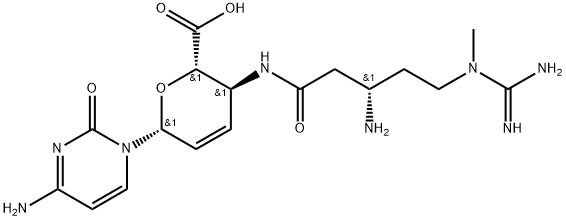??????-??
|
|
??????-?? ??
- ???
- 235°C
- ?? ?
- 539.06°C (rough estimate)
- ??
- D11 +108.4° (water)
- ??
- 1.1690 (rough estimate)
- ???
- Low
- ???
- 1.6910 (estimate)
- ???
- DMF: soluble; DMSO: soluble; Ethanol: soluble; Methanol: soluble; Water: soluble
- ??? ??
- ??
- ?? ?? (pKa)
- 2.4 (carboxyl), 4.6,8.0 and>12.5 (three bases)
- ???
- >30g l-1(20°C)
- ???
- ?? ???? ???? ????.
??
- ?? ? ?? ??
- ?? ? ???? ?? (GHS)
| ??? ?? | T+ | ||
|---|---|---|---|
| ?? ???? ?? | 28 | ||
| ????? | 24/25-36/37-45 | ||
| ????(UN No.) | 3172 | ||
| ?? ?? | 6.1(a) | ||
| ???? | II | ||
| HS ?? | 29349990 | ||
| ?? ?? ??? | 2079-00-7(Hazardous Substances Data) | ||
| ?? | LD50 i.v. in mice: 2.82 mg/kg (Takeuchi) | ||
| ???? ?? | KE-01170 | ||
| ?????? ??? | 97-1-117 | ||
| ?? ? ???? | ????: ????; ???(??)????: ??????-??? ? ?? ? ? ? ??? 1% ?? ??? ??? |
??????-?? C??? ??, ??, ??
??
Nucleoside antibiotic produced by Streptomyces griseochromogenes (1). Biosynthesized from cytosine, glucose, arginine, and methionine (2).??
Blasticidin S is a nucleoside produced by several species of Streptomyces, first reported in the late 1950s. Blasticidin S is an antifungal agent with particularly potent activity against the rice pathogen, Piricularia oryzae, for which it was used commercially for some time in Japan. Blasticidin S inhibits protein synthesis and is active against bacteria, tumour cell lines and nematodes. More recently, blasticidin S has been used as a marker for strain manipulations. Blasticidin S provided by BioAustralis is presented as the free base to avoid problems associated with the use of the hydrochloride.??
ChEBI: A blasticidin that is an antibiotic obtained from Streptomyces griseochromogene.?? ??
Blasticidin S is produced by Streptomyces griseochromogenes, and has a wide range of antimicrobial activity (4). This antibiotic was utilized in the Far East beginning in 1961 against the rice blast pathogen Pyricularia oryzae, with effective control achieved at rates of 10–40 ppm (4).?? ??
Blasticidin S was found in the culture broth of Streptomyces griseochromogenes by Yonehara et al. of the University of Tokyo in 1958. It has a nucleoside-analogue structure and shows strong activity against phytopathogenic fungi, especially Pericularia oryzae, the pathogen causing rice blast. Blasticidin S has been used to protect rice plants.Pharmacology
Inhibits protein synthesis both in eukaryotes and in prokaryotes (5,6). Interacts with ribosomal RNA in large subunit, interfering with the transpeptidation step. Inhibits cell-free protein synthesis in P. oryzae and Escherichia coli.?? ?? ??
Several blasticidin S-resistant microorganisms are found to produce blasticidin S deaminase which catalyzes the hydrolytic deamination of the cytosine moiety in blasticidin S to give a non-toxic deaminohydroxy derivative.?? ??
3H-blasticidin S administered to mice was excreted in the urine and feces within 24 h. Cytomycin and cytosin were identified as the main metabolites in and on rice plants, respectively (7). In soil, DT50 < 5 d. Metabolized to nontoxic deaminohydroxy blasticidin S by Aspergillus sp. and resistant Bacillus cereus. Novel deaminase and coding genes, BSD and bsr, were isolated as selectable marker genes for genetic engineering (8).??????-?? ?? ?? ? ???
???
?? ??
??????-?? ?? ??
???( 57)?? ??
| ??? | ?? | ??? | ?? | ?? ? | ?? |
|---|---|---|---|---|---|
| Hubei Jusheng Technology Co.,Ltd. | 18871490254 |
linda@hubeijusheng.com | CHINA | 28172 | 58 |
| Hubei xin bonus chemical co. LTD | 86-13657291602 |
linda@hubeijusheng.com | CHINA | 22963 | 58 |
| career henan chemical co | +86-0371-86658258 +8613203830695 |
factory@coreychem.com | China | 29808 | 58 |
| Shaanxi Dideu Medichem Co. Ltd | +86-029-89586680 +86-18192503167 |
1026@dideu.com | China | 7859 | 58 |
| SUZHOU SENFEIDA CHEMICAL CO.,LTD | +86-0512-83500002 +8618501500038 |
3899766280@qq.com | China | 26362 | 58 |
| LEAPCHEM CO., LTD. | +86-852-30606658 |
market18@leapchem.com | China | 43340 | 58 |
| XIAMEN AMITY INDUSTRY AND TRADE CO., LTD. | +8618950047208 |
ellena@amitychem.com | China | 43416 | 58 |
| Beijing HuaMeiHuLiBiological Chemical | 010-56205725 |
waley188@sohu.com | China | 12335 | 58 |
| Shandong Xiya Chemical Co., Ltd. | 4009903999 13395398332 |
sales@xiyashiji.com | China | 20806 | 60 |
| Raw material medicin reagent co.,Ltd | |
sales@njromanme.com | China | 4529 | 58 |
??????-?? ?? ??:
?????? ???? ????? ???? ????? ??????-??
DODECYLBENZENE
H-BETA-ALA-BETA-ALA-OH
Demethylblasticidin S
BLASTICIDIN S HCL,BLASTICIDIN S, HYDROCHLORIDE, STREPTOMYCES GRISEOCHROMOGENES,BLASTICIDIN S HYDROCHLORIDE
Blasticidin H
blasticidin A
blasticidin S deaminase
BLASTICIDIN S HCL UN2811-
blasticidin S-acetyltransferase
Blasticidin S, HCl, Streptomyces griseochromogenes
Blasticidin S sodium salt
BLASTICIDIN S HCL,BLASTICIDIN S HYDROCHLORIDE,BLASTICIDIN S, HYDROCHLORIDE, STREPTOMYCES GRISEOCHROMOGENES,Blasticidin S benzylaminobenzenesulfonate







